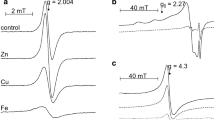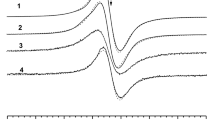Abstract
Effect of metal ions on free radical properties of natural melanin produced by soil fungiCladosporium cladosporioides was studied. The electron paramagnetic resonance (EPR) spectrum of the studied melanin consists mainly of a single line of eumelanin, and only a very weak signal of pheomelanin was observed. o-Semiquinone free radicals form paramagnetic centers in melanin. Diamagnetic Zn2+ ions produce an increase in the free radical concentration in melanin. Quenching of melanin EPR lines was obtained for melanin and paramagnetic Cu2+ ion complexes. Slow spin-lattice relaxation processes are characteristic for the free radicals in melanin samples and fast spin-lattice relaxation was observed for Cu2+ ions. The EPR lines of copper ions saturate at higher microwave powers than the EPR lines of melanin.
Similar content being viewed by others
References
Buszman E.: Habilitation thesis, Medical University of Silesia, Katowice, Poland, 1994.
Butler M.J., Day A.W.: Can. J. Microbiol.44, 1115–1136 (1998)
Pasenkiewicz-Gierula M., Sealy R.C.: Biochim. Biophys. Acta884, 510–516 (1986)
Sarna T., Hyde J.S., Swartz H.M.: Science192, 1132–2234 (1976)
Sarna T., Froncisz W., Hyde J.S.: Arch. Biochem. Biophys.202, 304–313 (1980)
Sealy R.C., Felix C.C., Hyde J.S., Swartz H.M. in: Free Radicals in Biology (Pryor W.A., ed.), vol. IV, pp. 209–259. New York: Academic Press 1980.
Froncisz W., Sarna T., Hyde J.S.: Arch. Biochem. Biophys.202, 289–303 (1980)
Felix C.C., Hyde J.S., Sarna T., Sealy R.C.: J. Am. Chem. Soc.100, 3922–3926 (1978)
Buszman E., Latocha M., Pilawa B., Wilczok T.: Pol. J. Med. Phys. Eng.1(2), 121–126 (1995)
Pilawa B., Buszman E., Latocha M., Wilczok T.: Pol. J. Med. Phys. Eng.2(3), 59–65 (1996)
Buszman E., Pilawa B., Latocha M., Wilczok T., Tyrawska-Spychałowa D., Bajan D., Bijak A., Bilińska B.: Curr. Top. Biophys.22, 21–24 (1998)
Jastrzębska M.M., Isotalo H., Paloheimo J., Stubb H., Pilawa B.: J. Biomater. Sci. Polymer Edn.7, 781–793 (1996)
Buszman E., Kopera M., Wilczok T.: Biochem. Pharmacol.33, 7–11 (1984)
Pilawa B., Buszman E., Latocha M., Wilczok T. in: Proceedings of the International Conference on Medical Physics and Engineering in Health Care jointly with 12th Congress of the Polish Society of Medical Physics, p. 49, Poznań 2001.
Pawelek J.M., Korner A.M.: Am. Sci.70, 136–145 (1982)
Wertz J.E., Bolton J.R.: Electron Spin Resonance: Elementary Theory and Practical Applications. New York: Academic Press 1986.
Pasenkiewicz-Gierula M.: Ph.D. thesis, Jagiellonian University, Kraków, Poland, 1978.
Author information
Authors and Affiliations
Rights and permissions
About this article
Cite this article
Buszman, E., Pilawa, B., Witoszyńska, T. et al. Effect of Zn2+ and Cu2+ on free radical properties of melanin fromCladosporium cladosporioides . Appl. Magn. Reson. 24, 401–407 (2003). https://doi.org/10.1007/BF03166942
Received:
Revised:
Issue Date:
DOI: https://doi.org/10.1007/BF03166942




